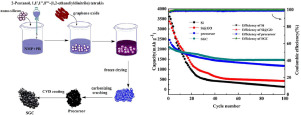Journal of Energy Storage ( IF 9.4 ) Pub Date : 2019-12-20 , DOI: 10.1016/j.est.2019.101075 Yuehua Huang , Jing Luo , Jiao Peng , Minhao Shi , Xingxing Li , Xianyou Wang , Baobao Chang

|
The porous silicon-graphene-carbon (SGC) composite is prepared by freeze-drying and chemical vapor deposition (CVD) process with commercially available nano-silicon, phenolic resin and graphene oxide as raw materials. The self-assembly process makes the nano-silicon into a porous structure and uniform recombination with the graphene oxide, and finally a nano-carbon layer is coated on the surface of the SGC composite by a CVD process. The composition, morphology and pore properties of SGC composite are characterized by X-ray diffraction (XRD), scanning electron microscopy (SEM) and pore size analysis. The nano-carbon layer on the surface of the SGC is examined by transmission electron microscopy (TEM) and Raman spectrometer. The contents of C, Si and O in precursor and SGC are analyzed by X-Ray Fluorescence (XRF), and the electrochemical performances of composite material are analyzed by half-cell and full-cell experiments. The results show that the SGC composite is porous structure with the average pore size of 20–30 nm, and the surface of the porous silicon-graphene is coated by a thickness of 5 nm carbon layers. The reversible capacity and initial coulombic efficiency (ICE) of the SGC are 2180 mAh g−1 and 79.3%. The capacity retention is higher than 70.1% after 100 charge/discharge cycles by the half-cell experiment; and the capacity of the composite anode is still as high as 550 m Ah g−1 after 820 charge/discharge cycles by full-cell experiment. Therefore, the structure design strategy of the composite is beneficial to buffer the volume effect of nano-silicon, prevent iterative growth of the SEI film and boost the electrochemical performances.
中文翻译:

多孔硅-石墨烯-碳复合材料作为锂离子电池的高性能负极材料
多孔硅-石墨烯-碳(SGC)复合材料是通过冻干和化学气相沉积(CVD)工艺制备的,以市售纳米硅,酚醛树脂和氧化石墨烯为原料。自组装过程使纳米硅成为多孔结构并与氧化石墨烯均匀地再结合,最后通过CVD工艺将纳米碳层涂覆在SGC复合材料的表面上。通过X射线衍射(XRD),扫描电子显微镜(SEM)和孔径分析对SGC复合材料的组成,形貌和孔性能进行了表征。通过透射电子显微镜(TEM)和拉曼光谱仪检查SGC表面的纳米碳层。用X射线荧光光谱(XRF)分析前驱体和SGC中C,Si和O的含量,通过半电池和全电池实验对复合材料的电化学性能进行了分析。结果表明,SGC复合材料为多孔结构,平均孔径为20–30 nm,并且多孔硅石墨烯的表面覆盖有5 nm的碳层厚度。SGC的可逆容量和初始库仑效率(ICE)为2180 mAh g-1和79.3%。半电池实验表明,经过100次充电/放电循环后,容量保持率高于70.1%;经过全电池实验,经过820次充放电循环后,复合阳极的容量仍高达550 m Ah g -1。因此,复合材料的结构设计策略有利于缓冲纳米硅的体积效应,防止SEI膜的迭代生长,提高电化学性能。


























 京公网安备 11010802027423号
京公网安备 11010802027423号